Tillandsia Apretado
Click thumbnails for full size, scaled to a new window.
Tillandsia Apretado
cultivar of ionantha
Now registered as two seperate plants, 'Apretado RFI' and 'Apretado BRT'.
See discussions below, ionantha cultivars list this website, and BCR register notes.
From BCR ... 'Apretado RFI' ? / Delago, Frenchy* <1971
Mature, small, tight-leaved rosette, variable from 1cm. to 5cm tall x to 2cm. wide. In strong light, finely-scurfed, distinctly-triangular, wide-sheathed, olive green to salmon orange/pink leaves. At blooming, inner leaves turn bright pink/scarlet with exserted purple tubular flowers. About 1974 Paul Isley obtained a single offset of T. 'Apretado' from local fellow Los Angeles grower Frenchy Delago who named it. It's history prior to that date is unrecorded. In Spanish the word "apretado" means "tight". Renamed 'Apretado RFI' (= Rainforest Flora Inc) to differentiate from T. 'Apretado BRT' (= Bird Rock Tropicals). Ionantha Group. Reg. Doc. 5/2018 by G Lawn. Country of origin: ? / California USA
References: Tillandsia (1975), p.64.P Isley; Tillandsia (1987), p.64
From BCR ... 'Apretado BRT' ? / Koide Hyatt, P *, circa 1982
Mature, solid, ovoid-shaped rosette to 12cm. high x 6cm. diameter. Rather large for a T. ionantha cultivar. Tightly constricted, non-flaring, succulent mid-green, pointed leaves, considerably laden with white trichomes towards the base. Although sometimes reluctant to bloom in cultivation (it just keeps growing), upper leaves turn scarlet with the semi-recessed inflorescence imminent, which has long, tubular violet flowers. Wild-collected in Mexico by Pamela Koide Hyatt circa 1982, exact locality unrecorded and herein renamed with the initials "BRT" (= Bird Rock Tropicals) because it was mistakenly identified for many years as the other T. 'Apretado RFI' (= Rainforest Flora Inc.). Ionantha Group. Reg. Doc. 5/2018 by G. Lawn. Country of origin: Mexico
References: BSI Journal 43: 163 (1993). New Tillandsia Handbook, H. Shimizu & H Takizawa, p.61.(1997) Bird Rock Tropicals, collection no.T100-cv. A.
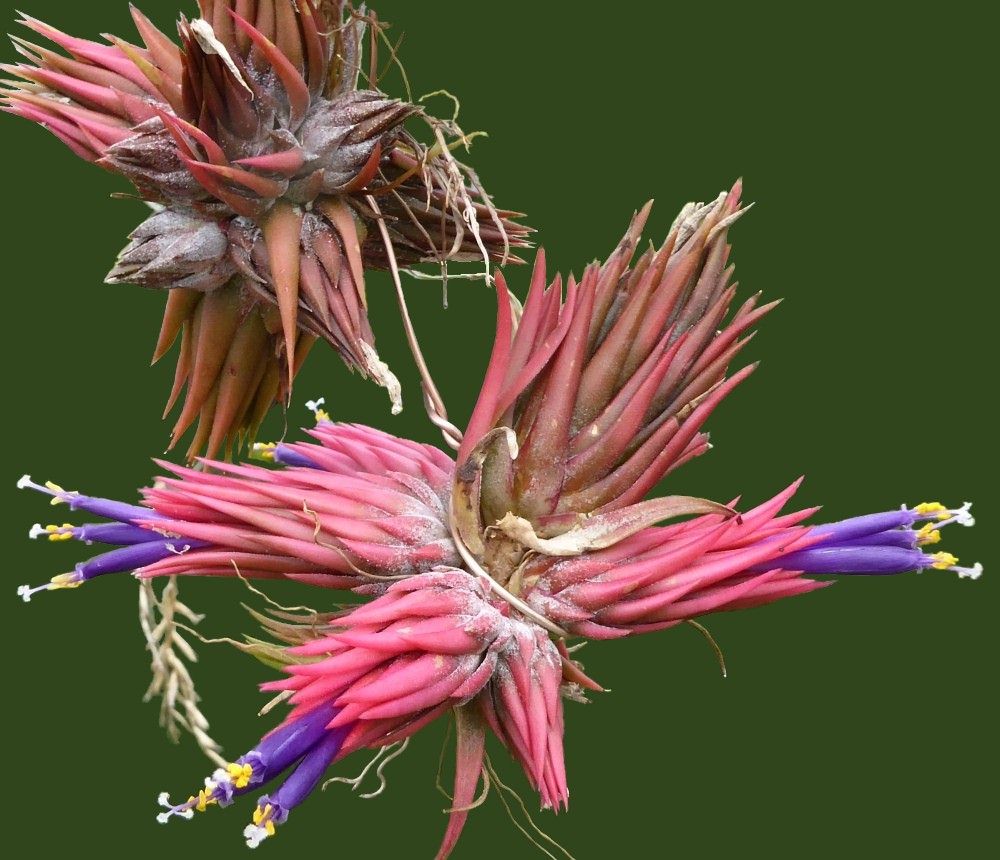
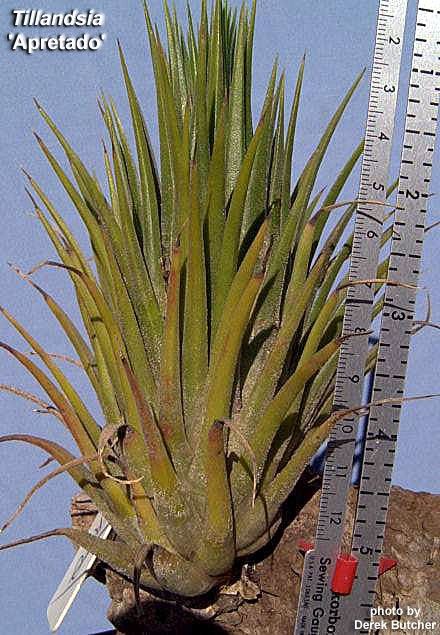
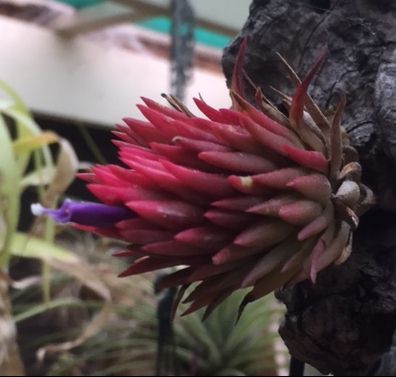
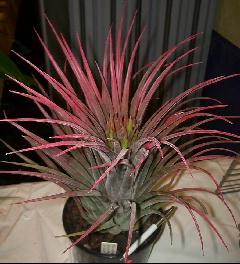
| Chris Larson 12/14 ex. RFI |
Derek Butcher 11/03 |
Steve Morgan 03/17 |
Ian Hook, Sydney 05/04. Giant form, "possibly Apretado" |

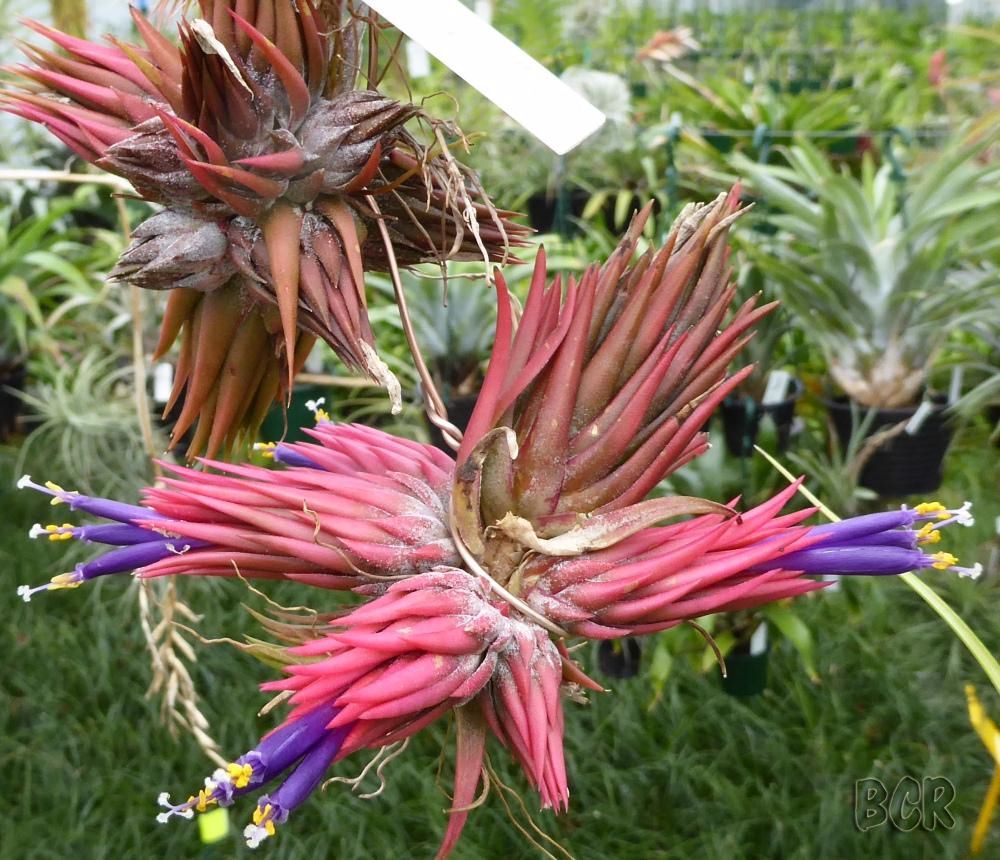

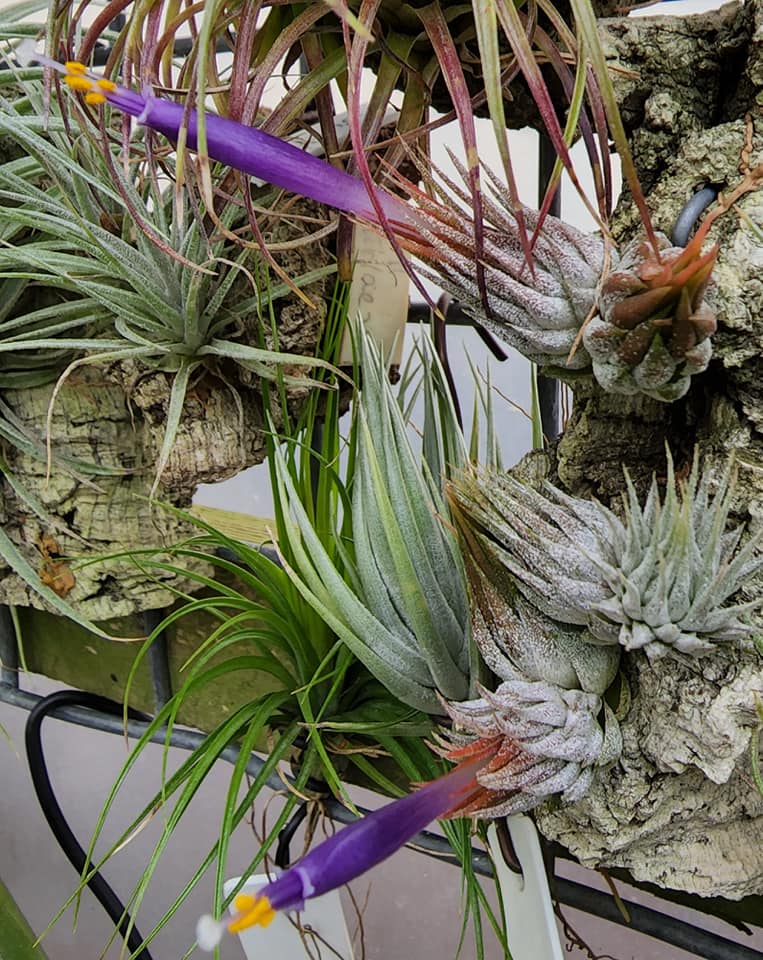
Apretado BRT
BCR=#14772, photo: Pamela Koide-Hyatt. Bird Rock Tropicals. Slow growing and therefore large at flowering. 12cm high x 6cm wide |
Apretado RFI
BCR=#14773, photo: Chris Larson. 1cm to 5cm high x 2cm wide. Rainforest Flora Inc. |
Chris Larson 06/22 Apretado RFI
High light compared to low light. |
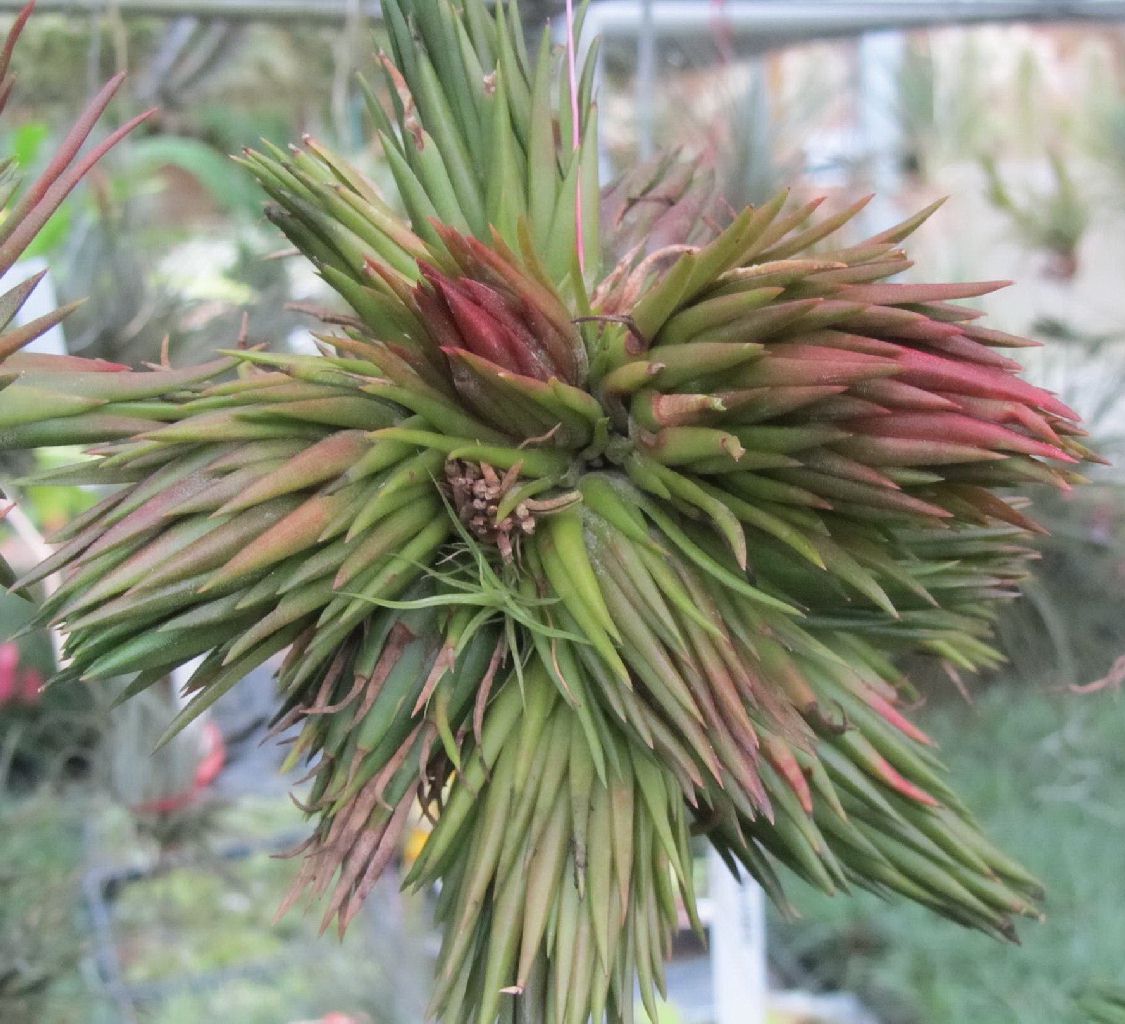
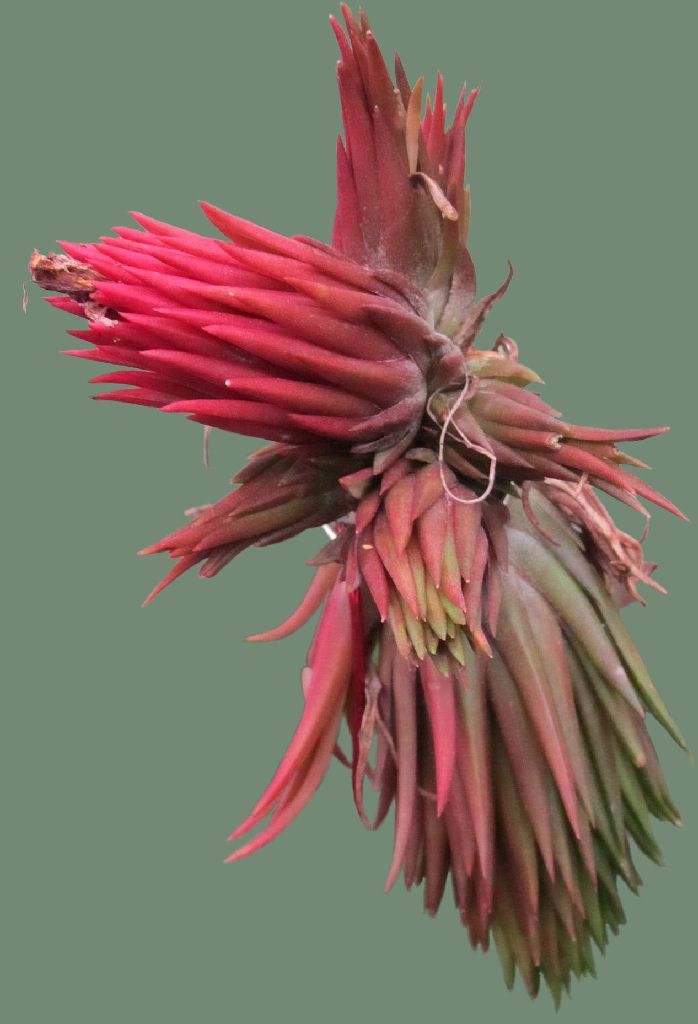
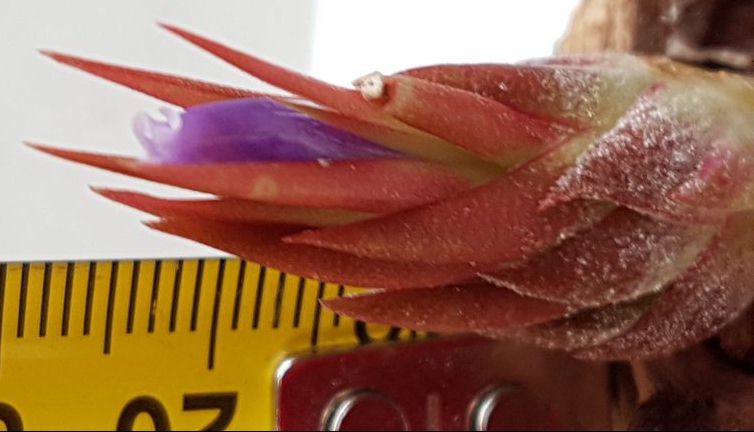
| Peter Tristram from RFI, 2012 |
Kerry McNicol 03/18 |
Tillandsia discussion group notes leading to renaming as "...BRT" or "...RFI".
Geoff Lawn 6/3/18 ... to Pamela Hyatt
Thanks, Pamela for both photos of Till 'Apretado'--now added to the BCR entry at: http://registry.bsi.org/?fields=Name&id=7982&search=Apretado.
Chris Larson 6/3/18 ... Hi Pam. I do not pretend to be knowledgeable with regard to this cv, but it does raise some thoughts.
I could only find 1 photo of T. Apretado of Pam's on the BCR - where Geoff says that there are 2. However it does not appear to be what I have received from Paul Isley under this name. All plants I received from Paul have been consistent with this photo (http://registry.bsi.org/showImg.php?showImage=24&id=18602) the main difference (from Pam's) being that what I have are almost devoid of scales.
Kevin & Sam from Singapore have bought T. Apretado from Paul over many years and have received the same plants as mine.
My Isley plants flower regularly, anywhere from 1cm tall to approx. 2.5cm. The size thing with T. ionantha is very variable with their environment. Some will only grow to size if they do not flower for an extended period of time. Whether they flower regularly depends on cultural conditions. (Some of my larger ionantha forms will not reach any real size for Peter Sargent - north of Cairns, for example.)
Geoff Lawn 7/3/18 ... On the BCR entry of T. Apretado, there are 5 images on the top row. Scroll to the extreme right photo to see Pamela's first photo and of course the second row photo is Pamela's also.
Pamela said in a private message that Paul Isley's photo (second on the left) in the BCR entry does not look like Apretado to her. So before I remove it, I want it identified, so it can have a new "home". Isley's Til
Book 1 shows a so-called T. Apretado on page 64 but the image bears little resemblance to his all-red Apretado in the BCR photo--is it clonal or cultural differences ? So some clarification is needed. The BCR entry
indicates that Paul Isley named it Apretado, but I don't know where his nursery stock came from.
Pamela's 1993 article in the BSI Journal (July-Aug. issue, page 163 ) indicates she wild-collected Apretado in Mexico. More comments, Pamela ?
Peter Tristram 7/3/18 (see pictures above) ... Attached are a couple of pics I took at RFI in LA in 2102 of what Paul sells as Apretado. It is very distinctive. The ones I photographed look to be the plant in Paul's picture in the BCR. He told me that this one, Ron, Monstrose, Two Tone and some others, were each single clones and all plants from him with these labels were identical - not variable from wild collections or seed raising. Chris's plants came from this stock at the LA facility which I packed and brought with all of my Isley purchases back on the plane - quite an effort I remember!! As Chris says, Paul has sold 'Apretados' in Asia, in fact all over the world. I guess the original plant came from Mexican collections, as Pam describes, but is not used as a generic name, like Huamelula was before var. maxima was assigned to it.
Kerry McNicol 7/3/18 ... (see picture above) 7/3/18 Attached is my flowering 'Apretado'. As you can see it is only a couple of cm tall when it flowered. Not as per description. I believe (according to records) I got this from Chris in Autumn 2016.
Geoff Lawn 7/3/18 ... I haven't contact Paul Isley and don't intend to. Whether all the BCR photos represent the one clone under different culture / position and climate variations, hence different leaf growth, flowering pattern etc, I have no idea . Maybe further sporting has occurred. Should I call in the DNA researchers ? I'm told Apretado is a catch-up job, so who knows after all these years what is a true representation?
Peter Tristram 7/3/18 ... I guess this one's between Pam and Paul. They might even be selling the same plant! Looking at the cost on both the BRT and RFI websites it looks like a single clone propagation situation as Paul told me it is with his Apretado. Pam, do you have a T number for your Apretado?
Kerry, some of RFI's Apretados bloom as baby pups, others grow quite large. All have the finely scurfed, wide sheaths and distinctively triangular leaves. RFI's colour deep burgundy red too in moderate to bright light. One of the most distinctive ionanthas imho.
Derek Butcher 7/3/18 ... I won't enter the Californian differences but was intrigued with Kerry's plant. When I used to look at Margaret's collection I was interested in the number of offsets that did not look like mother but this Sporting did not last and the offset slowly went back to mother's shape. I understand that Kerry does not have the plant because someone saw the opportunity to 'borrow' it but would have asked her if the aberrant plant produced Apretado offsets. Certainly the oval leaves and fluffy trichomes were a surprize.
Chris Larson 7/3/18 ...I really do not see the issue of any bromeliad having different characteristics under different conditions, or some generations varying due to the conditions of the time. The basic underlying traits are usually present in differing ways depending on culture.
Looking at my T. Apretado today, they have similar trichomes as per Kerry's photo - but largely the trichomes (esp towards the leaf tip) are not obvious as most other ionanthas. Also some of the small pups have more obvious fine trichomes.
One thing we can be quite sure of, based on purchases by the Singaporean guys (who have dealt with RFI for years) and Peter & I, along with the photos of Paul's on the BCR - and he happens to be the person who registered the plant - this plant has been sold by Paul for quite some time under this name. The basic shape & look of Peter's, Paul's & Kerry's photos are consistent. I would consider that Paul's comments on this matter, as the originator of this plant, is probably relevant - mainly due to the fact that a large number of plants under this name, in the till growing fraternity would be of this type.
Before obtaining these plants a couple of years ago, I thought T. Apretado to be a large plant. So much so that I questioned the Singaporeans, Sam & kevin, whether my plants had the right name. They just said something like - "no, that's it. That's what Isley always sells as Apretado".
Obviously, there are a lot of plants also circulating under this name similar to those in Pam's photo.
Pamela Koide-Hyatt 8/3/18 ... It looks like the plant that Paul is selling is different than my Apretado. I too have sold it around the world, and mine are all offsets from original collections. T number is T100-cvA. Mine does look like the one in HIro's Tillandsia Handbook. Mine get large and do have more trichomes than what appears on Paul's. What do you suggest - a new name for mine?
Pamela Koide Hyatt, Bird Rock Tropicals
Peter Tristram 9/3/18 ... I have T100, a nice chunky ionantha but certainly different to Paulís plant. Maybe itís easiest to just use Birdrock or BRT Apretado and RFI Apretado? I usually add the source on my labels anyway and have sold a couple of your T100 as ĎT. ionantha BRT T100í, not realising it was actually your Apretado (quarantine issues with names!).
Derek Butcher 9/3/18 ... Such are the problems of giving cultivar names for plants found in the wild and treating them the same as manmade hybrids where the grex can be traced. Someone should write an article explaining that over 30 years ago Paul Isley chanced upon a 'different' looking ionantha that he called 'Apretado' (Spanish for Tight). The name was not registered and therefore not defined. Years later Pam found a plant in the wild that looked like 'Apredato' and which she sold as 'Apredato'.
With your suggestion we would have 3 options for a name. Nobody has yet come up with a differential diagnosis. What happens to the thousands of 'Apretado' out there that would be wrongly named if your suggestion were followed. A better solution is surely to keep the status quo BUT explaining in notes or a separate word doc the situation. If only plants were made from plastic where there would be no evolution.
Geoff Lawn 10/3/2018 ... This saga is closing after much discussion with all concerned. So registered are 2 different types of T. Apretado' with different histories.
1. T. 'Apretado BRT'. See: http://registry.bsi.org/?id=14772&whatsnew#14772
2. T. 'Apretado RFI'. See: http://registry.bsi.org/?id=14773&whatsnew#14773
I have used ony those photos directly linked to the discoverers or cultivar raisers. Tillandsia collectors will need to sort out which type they grow and relabel accordingly.
Tillandsia 'Apretado' by P. Koide in J Brom Soc 43: 163. 1993 (Now 'Apretado BRT')
Appears to be a variation of the Mexican T. ionantha var. ionantha. I have on occasion, found specimens of it growing in Mexico. They seem to grow larger than the typical species, and the leaves are succulent, slightly stiffer and more erect. They grow quite large as they are reluctant to bloom.
Updated 15/06/22










